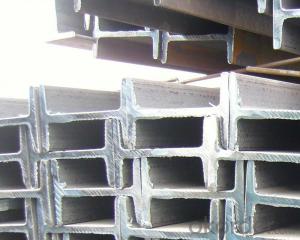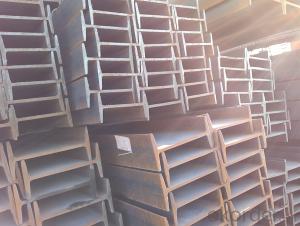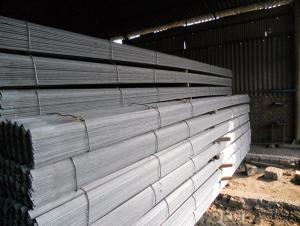Structural Steel I Beams
- Loading Port:
- Tianjin Port, China
- Payment Terms:
- TT or LC
- Min Order Qty:
- 25MT m.t.
- Supply Capability:
- 10000MT m.t./month
OKorder Service Pledge
OKorder Financial Service
You Might Also Like
Specifications of Structural Steel I Beams
Material of Structural Steel I Beams:Q235,SS400,A36,ST37-2,EN10025,DIN10025,S235JR
|
Alloy No. |
Grade |
C |
Mn |
S |
P |
Si |
|
Q235 |
B |
0.12%-0.20% |
0.3%-0.7% |
<=0.045% |
<=0.045% |
<=0.3% |
Sizes: 80MM-270MM

Length: 5.8M, 6M, 9M, 12M or as the requriements of the clients


Usages of Structural Steel I Beams
According to the needs of different structures, structural steel I beams can compose to different force support component, and also can be the connections between components. They are widely used in various building structures and engineering structures such as roof beams, bridges, transmission towers, hoisting machinery and transport machinery, ships, industrial furnaces, reaction tower, container frame and warehouse etc.


Packaging & Delivery of Structural Steel I Beams
1. Packing: it is nude packed in bundles by steel wire rod
2. Bundle weight: not more than 3.5MT for bulk vessel; less than 3 MT for container load
3. Marks:
Color marking: There will be color marking on both end of the bundle for the cargo delivered by bulk vessel. That makes it easily to distinguish at the destination port.
Tag mark: there will be tag mark tied up on the bundles. The information usually including supplier logo and name, product name, made in China, shipping marks and other information request by the customer.
If loading by container the marking is not needed, but we will prepare it as customer request.


4. Transportation: the goods are delivered by truck from mill to loading port, the maximum quantity can be loaded is around 40MTs by each truck. If the order quantity cannot reach the full truck loaded, the transportation cost per ton will be little higher than full load.

5. Delivered by container or bulk vessel
6. Delivery time: All the structural steel I beams will be at the port of the shipment within 45 days after receiving the L/C at sight ot the advance pyment.
7. Payment: L/C at sight; 30% advance payment before production, 70% before shipment by T/T, etc.
Production flow of IPE/IPEAA Beams
Material prepare (billet) —heat up—rough rolling—precision rolling—cooling—packing—storage and transportation
- Q: Can steel I-beams be used for chemical processing plants?
- Yes, steel I-beams can be used for chemical processing plants. Steel is a commonly used material in these types of industrial applications due to its strength, durability, and resistance to corrosion. I-beams, specifically, are often used in structural framing to provide support and stability to the overall structure of the plant. Chemical processing plants typically involve the handling and processing of various chemicals and substances, some of which can be highly corrosive or hazardous. Steel, especially when coated or treated with corrosion-resistant materials such as galvanization or specialized coatings, can withstand the harsh conditions found in chemical processing environments. Additionally, steel I-beams offer several advantages for chemical processing plants. They have a high load-bearing capacity, allowing them to support heavy equipment, piping, and storage tanks. The flexibility and versatility of steel make it easier to construct complex designs and accommodate the changing needs of the plant. However, it is important to note that the specific requirements of each chemical processing plant may vary, and it is crucial to consider factors such as the type of chemicals being processed, temperature, pressure, and other environmental conditions. Consulting with structural engineers, architects, and relevant experts is recommended to ensure the appropriate selection, design, and installation of steel I-beams for a chemical processing plant.
- Q: Are steel I-beams resistant to chemical exposure?
- Chemical exposure is generally not a concern for steel I-beams. Steel, known for its durability and versatility, is highly resistant to various elements, including chemicals. However, the level of resistance can vary depending on the specific chemical and its concentration. In everyday environments, such as water, air, and mild acids or alkalis, steel I-beams are resilient and can withstand exposure. They can handle moisture without corroding or degrading, making them suitable for construction, infrastructure, and industrial applications. However, highly corrosive chemicals or aggressive substances may affect steel I-beams to some extent. Strong acids, alkaline solutions, or corrosive materials with high concentrations can gradually deteriorate the steel surface, potentially weakening its structure over time. To enhance the resistance of steel I-beams in such conditions, it is important to consider the specific chemical environment and consult experts or engineers for additional protective measures, like coatings or barriers. In conclusion, while steel I-beams inherently resist chemical exposure, it is crucial to assess the specific chemical environment and take appropriate measures to ensure their long-term durability and performance.
- Q: Can steel I-beams be used for pedestrian bridges over rivers or canals?
- Yes, steel I-beams can be used for pedestrian bridges over rivers or canals. Steel I-beams are commonly used in bridge construction due to their strength, durability, and ability to span long distances. They provide excellent load-bearing capacity, making them suitable for pedestrian bridges that need to support the weight of people and other loads. Additionally, steel I-beams are resistant to corrosion, making them ideal for bridge structures exposed to water environments.
- Q: What are the different types of connections used for steel I-beams in seismic areas?
- In seismic areas, the connections used for steel I-beams are crucial for ensuring the structural integrity and safety of the building. There are several different types of connections that are commonly used: 1. Welded Connections: Welding is the most common method of connecting steel I-beams in seismic areas. It involves fusing the steel members together using heat and pressure. Welded connections provide excellent strength and rigidity, making them suitable for seismic applications. However, they require skilled labor and careful inspection to ensure proper quality and adherence to building codes. 2. Bolted Connections: Bolted connections involve using high-strength bolts to secure the steel I-beams together. This type of connection allows for easier installation and disassembly compared to welding. It also provides a certain level of flexibility, allowing for some movement during seismic events. However, bolted connections may require periodic inspection and maintenance to ensure the integrity of the bolts. 3. Moment Connections: Moment connections are specifically designed to resist the rotational forces that occur during seismic events. This type of connection allows for the transfer of bending moments between steel beams and columns, ensuring the overall stability of the structure. Moment connections are typically welded and require careful engineering and design to ensure their effectiveness in seismic areas. 4. Shear Connections: Shear connections are used to transfer lateral forces between steel beams and columns. They are designed to withstand the shear forces that occur during seismic events. Shear connections can be achieved through welding or bolting, depending on the specific requirements of the project. These connections are crucial for maintaining the overall stability and strength of the structure. 5. Reduced Beam Section (RBS) Connections: RBS connections are a specialized type of connection used in seismic areas to improve the ductility and energy dissipation capacity of steel I-beams. This connection involves reducing the cross-section of the beam near the connection point, which helps to absorb and dissipate the energy generated during seismic events. RBS connections are typically designed using a combination of welding and bolting techniques. It is important to note that the specific type of connection used for steel I-beams in seismic areas will depend on various factors, including the design requirements, building codes, and the expertise of the structural engineer. Proper design, installation, and maintenance of these connections are essential to ensure the structural integrity and safety of buildings in seismic areas.
- Q: Can steel I-beams be used in mezzanine or elevated platform construction?
- Absolutely! Mezzanine or elevated platform construction can indeed incorporate steel I-beams. These beams are widely utilized in the construction industry owing to their robustness and structural reliability. They offer exceptional support and stability to mezzanine and elevated platform structures. Moreover, steel I-beams can be customized and installed to meet the precise load specifications and architectural design of any project. Their versatility enables them to be employed in numerous construction applications, including mezzanines and elevated platforms.
- Q: How do steel I-beams perform in areas with high humidity?
- Steel I-beams generally perform well in areas with high humidity. While high humidity can contribute to corrosion over time, the performance of steel I-beams is largely determined by the protective coatings applied to them. If these coatings are properly applied and maintained, they can effectively protect the steel from moisture and prevent corrosion. Additionally, steel is known for its durability and strength, which allows it to withstand the effects of high humidity without significant structural damage.
- Q: What are the different methods of maintaining steel I-beams over time?
- There are several methods that can be employed to maintain steel I-beams over time, ensuring their structural integrity and longevity. Some of the most common methods include: 1. Regular inspections: Regular visual inspections should be conducted to identify any signs of wear, corrosion, or damage on the I-beams. This can be done by trained professionals who can thoroughly examine the beams and identify any potential issues. 2. Cleaning: Regular cleaning of the I-beams is essential to remove any dirt, debris, or contaminants that may accumulate over time. This can be done using appropriate cleaning solutions and techniques to prevent any damage to the steel surface. 3. Rust prevention: Steel I-beams are susceptible to rust, which can weaken the structure over time. To prevent rust formation, protective coatings such as paint or specialized rust inhibitors can be applied on the surface of the beams. These coatings act as a barrier, preventing moisture and oxygen from coming into contact with the steel surface. 4. Repairing damaged areas: If any signs of corrosion or damage are detected during inspections, it is important to promptly repair or replace the affected areas. This can involve removing the damaged section, treating the underlying steel, and then reinforcing or replacing the section with new steel. 5. Strengthening measures: Over time, the load requirements or conditions of use may change, requiring additional structural support. Strengthening measures such as adding steel plates or braces can be implemented to enhance the load-bearing capacity of the I-beams. 6. Monitoring environmental factors: Environmental factors such as temperature, humidity, and exposure to chemicals can impact the integrity of steel I-beams. Regular monitoring of these factors and implementing appropriate measures to mitigate their effects can help maintain the beams over time. 7. Consulting with structural engineers: It is advisable to consult with structural engineers or professionals who specialize in steel structures to assess the condition of the I-beams and recommend specific maintenance methods. Their expertise can help identify any potential issues and determine the most effective maintenance strategies. Overall, regular inspections, cleaning, rust prevention, prompt repairs, strengthening measures, monitoring environmental factors, and seeking professional guidance are key methods for maintaining steel I-beams over time. By implementing these methods, the longevity and structural integrity of the I-beams can be preserved, ensuring their safe and efficient functioning.
- Q: Can steel I-beams be customized or fabricated to meet specific project requirements?
- Steel I-beams have the ability to be customized or fabricated in order to fulfill specific project requirements. These versatile structural elements can be altered in terms of their size, shape, and composition to accommodate various construction projects. By adjusting the length, width, and height of the I-beams according to the specific load requirements and architectural specifications, fabricators are able to modify them. Furthermore, the fabrication process permits the modification of other properties, including the grade of steel used, the thickness of the flanges and web, and the incorporation of additional features like holes or notches. This customization offers engineers and architects the opportunity to optimize the I-beams' strength, stiffness, and overall performance for their particular project, thereby ensuring that they conform to the necessary safety standards and structural demands.
- Q: How do Steel I-Beams perform in terms of insulation?
- Steel I-beams do not perform well in terms of insulation. As a structural material, steel has excellent strength and durability, but it is a poor insulator. Steel is a good conductor of heat, meaning it allows heat to transfer easily through its structure. This makes steel I-beams highly conductive and susceptible to thermal bridging, which can lead to heat loss or gain depending on the climate. To address this insulation challenge, additional insulation materials are often used alongside steel I-beams. These insulation materials, such as foam panels or fiberglass batts, are placed between or around the I-beams to minimize the heat transfer. This extra layer of insulation helps to create a more thermally efficient building envelope. It is important to note that the insulation performance of a building is not solely dependent on the steel I-beams. Other factors, such as the type and thickness of insulation materials, the overall building design, and the quality of installation, also play significant roles in achieving proper insulation.
- Q: What is the theoretical weight per metric ton of 30# I-beam?
- Commonly used hot rolled I-beam specifications are 28# and 32#, 30# is relatively new specifications.
1. Manufacturer Overview
| Location | Qinhuangdao, China |
| Year Established | 2000 |
| Annual Output Value | Above US$ 300 Million |
| Main Markets | Mid East; Africa; Southeast Asia; Brazil |
| Company Certifications | ISO 9001:2008; |
2. Manufacturer Certificates
| a) Certification Name | |
| Range | |
| Reference | |
| Validity Period |
3. Manufacturer Capability
| a) Trade Capacity | |
| Nearest Port | Tianjin; |
| Export Percentage | 70% - 80% |
| No.of Employees in Trade Department | 21-50 People |
| Language Spoken: | English; Chinese; |
| b) Factory Information | |
| Factory Size: | Above 400,000 square meters |
| No. of Production Lines | 2 |
| Contract Manufacturing | OEM Service Offered; |
| Product Price Range | Average |
Send your message to us
Structural Steel I Beams
- Loading Port:
- Tianjin Port, China
- Payment Terms:
- TT or LC
- Min Order Qty:
- 25MT m.t.
- Supply Capability:
- 10000MT m.t./month
OKorder Service Pledge
OKorder Financial Service
Similar products
Hot products
Hot Searches
Related keywords


























